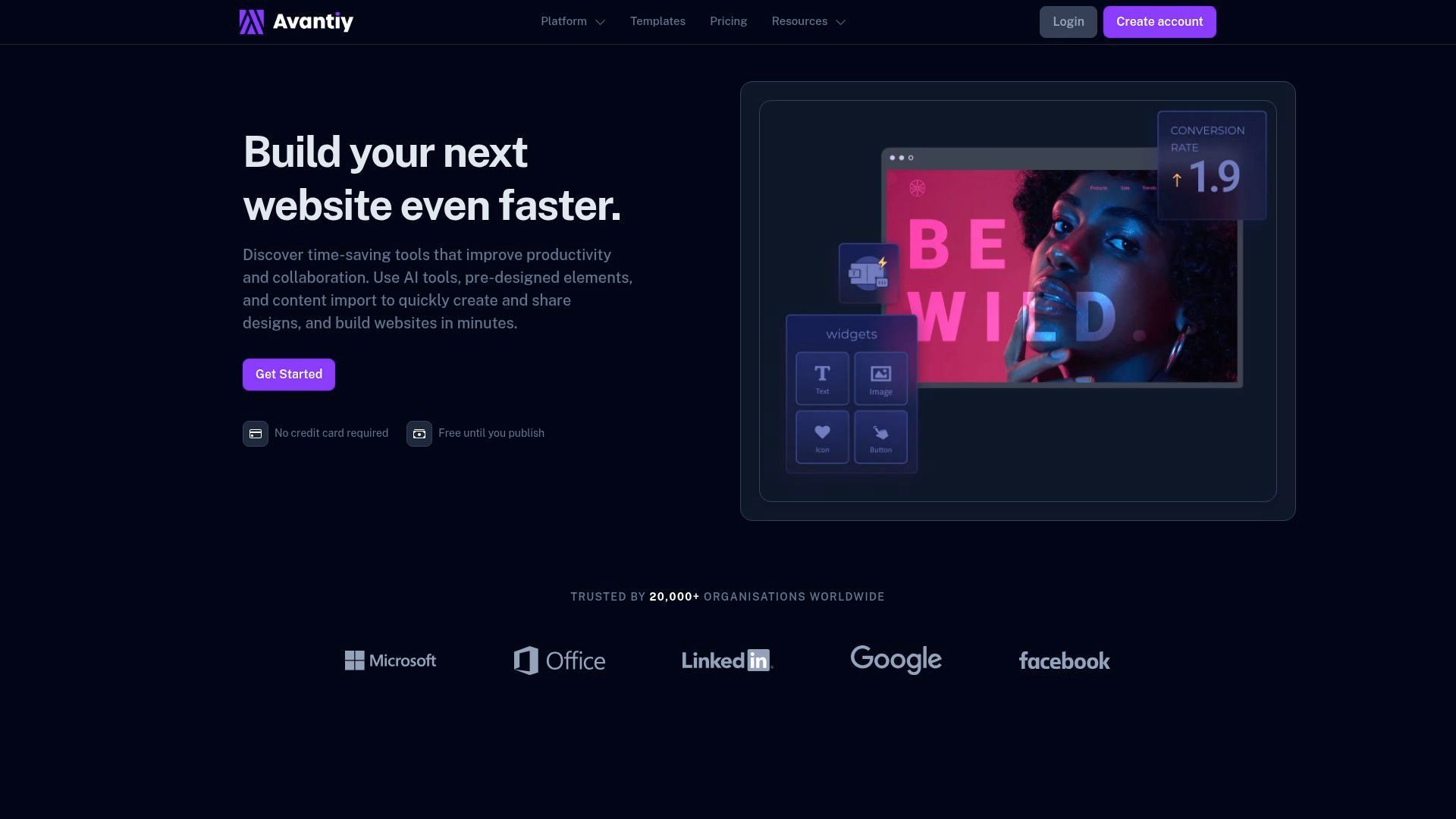In 2025, having just a single-page website simply isn’t enough. Users now expect a website with multiple pages, seamless navigation, and plenty of valuable content.
Businesses, creators, and professionals are all seeking sites that offer better SEO, improved user experience, and room to grow. Multi-page sites meet these needs and help you stand out in a crowded digital landscape.
This guide is your step-by-step roadmap for building a modern multi-page website from scratch—even if you’re a complete beginner.
You’ll learn how to plan, design, build, optimize, and maintain your site for long-term success.
Step 1: Planning Your Multi-Page Website
Before you start building a website with multiple pages, careful planning is the foundation for long-term success. By investing time upfront to clarify your goals, map out your structure, and research your competition, you’ll create a site that stands out and meets user expectations.

Defining Your Website’s Purpose and Goals
Start by pinpointing the primary purpose for your website with multiple pages. Who is your target audience, and what do you want them to do? Are you building a business site, personal portfolio, blog, or eCommerce store?
Clarify your objectives—this could be generating leads, showcasing your work, or selling products. Aligning your goals with your business needs ensures every page serves a role.
For example, a business site might focus on credibility and lead generation, while a portfolio highlights your skills and projects. Defining these elements early gives direction to your website with multiple pages and helps prioritize features that matter most.
Mapping Out Website Structure and Pages
Next, outline the structure for your website with multiple pages by creating a sitemap. Core pages usually include Home, About, Services, Blog, and Contact. Landing pages are tailored for campaigns or specific audiences.
Here’s a sample sitemap for different industries:
| Industry | Core Pages | Landing Pages |
|---|---|---|
| Business | Home, About, Services, Contact | Service-specific offers |
| Portfolio | Home, About, Work, Contact | Project case studies |
| eCommerce | Home, Shop, Cart, Checkout | Product promos |
Logical, intuitive navigation is key. According to experts, clear navigation enhances user retention, making it easier for visitors to find what they need and return in the future.
Content Planning and Organization
Once your structure is set, plan the content for each page on your website with multiple pages. Outline what content belongs where—think headlines, product descriptions, testimonials, or FAQs.
Use a content calendar to schedule updates and blog posts. Editorial planning ensures your messaging stays consistent and on-brand.
Map out user journeys so the most important information is easy to find. This step helps you place content where it will make the most impact, improving engagement across your website with multiple pages.
Research Competitors and Industry Standards
Gain inspiration by analyzing top-performing websites in your niche. Look at their layouts, content types, and features. What do they do well, and where do they fall short?
Pay special attention to how competitors structure their website with multiple pages. Gather ideas for navigation, calls to action, and visual hierarchy.
Industry statistics show that 63% of users prefer websites with clear navigation (HubSpot, 2023). Studying leaders in your field helps you set benchmarks and avoid common pitfalls.
Setting Up SEO Foundations
Effective planning for a website with multiple pages means setting a strong SEO foundation. Start with keyword research for each page, ensuring you target terms your audience is searching for.
Plan on-page SEO elements like unique titles, meta descriptions, and headings. Create an internal linking strategy to connect related content and boost both user experience and search engine rankings.
By integrating these SEO basics from the start, your website with multiple pages is primed for visibility and long-term growth.
Step 2: Choosing the Right Website Building Platform and Tools
Selecting the best platform is the foundation for building a website with multiple pages. Your choice will impact everything from design flexibility to scalability and ongoing maintenance. Let's break down the most important considerations so you can make a confident decision.
Evaluating Website Builder Options (SaaS, CMS, Custom Code)
When you’re planning a website with multiple pages, the platform you select matters. Common choices include SaaS website builders, content management systems (CMS), and custom-coded solutions.
| Platform | Ease of Use | Scalability | Cost | Best for |
|---|---|---|---|---|
| WordPress (CMS) | Moderate | High | Low–Medium | Blogs, Business, eCommerce |
| Wix/Squarespace | Easy | Moderate | Medium | Portfolios, Small Biz |
| Shopify | Easy | High | Medium–High | Online Stores |
| Custom Code | Hard | Very High | High | Unique Needs, Large Sites |
For most beginners, a user-friendly builder is ideal, but consider long-term needs as your website with multiple pages grows.
Essential Features for Multi-Page Websites
A strong website with multiple pages requires certain features to ensure a great experience for both you and your visitors.
- Multi-page navigation with customizable menus
- SEO tools for each page
- Responsive templates for all devices
- Fast loading times
- Integration with analytics and marketing tools
Did you know that mobile optimization dominates top-ranking websites? Over 60% of leading sites are mobile-optimized, which is essential for both SEO and user engagement.
Comparing Hosting Solutions
Hosting is the engine behind your website with multiple pages. Shared hosting is budget-friendly but may struggle with high traffic. Managed hosting offers better performance, security, and support.
For eCommerce or large content sites, robust hosting ensures uptime during traffic spikes. Always check for SSL certificates, daily backups, and scalability options.
A reliable host means your site stays fast, secure, and accessible as you add more pages.
Budgeting for Your Website Project
Building a website with multiple pages doesn’t have to break the bank. Here’s what to budget for:
- Domain registration
- Hosting fees
- Premium themes or templates
- Plugins or extensions
- Design assets (images, icons)
- Ongoing maintenance
Free tools can work, but premium options often unlock advanced features and better support. Plan your budget based on your site’s goals and expected growth.
Easily Build Multi-Page Sites with Avantiy
If you want to create a website with multiple pages quickly, Avantiy’s AI-powered platform is a game changer. Its drag-and-drop editor, customizable templates, and built-in SEO tools make it easy for anyone to launch a professional site.

Avantiy is perfect for non-coders, startups, and small businesses that need a scalable, high-performing website with multiple pages—no technical skills required.
Step 3: Designing Your Website Structure and Layout
Designing a website with multiple pages goes far beyond picking colors and fonts. The right structure sets the foundation for everything that follows. A well-designed layout ensures that visitors can explore your content with ease, find what they need quickly, and enjoy a seamless experience from page to page.
Let’s break down the essential design elements that make a website with multiple pages successful in 2025.

Crafting an Intuitive Navigation System
Navigation is the backbone of any website with multiple pages. Without a clear and intuitive menu, visitors can easily feel lost, leading to frustration and a quick exit from your site.
Start by mapping out your main pages, such as Home, About, Services, Blog, and Contact. Use a logical hierarchy, grouping related pages under dropdowns if needed. Sticky menus help keep navigation accessible, while mobile users benefit from hamburger or collapsible menus.
- Keep navigation labels simple and descriptive.
- Limit top-level menu items to 5–7 for clarity.
- Highlight the current page for user orientation.
A well-structured navigation system guides users smoothly throughout your website with multiple pages, improving engagement and satisfaction.
Designing Consistent Page Templates
Consistency is key when building a website with multiple pages. Uniform headers, footers, and sidebars create familiarity, so users always know where to find information.
Use template systems in your website builder or CMS to maintain this consistency. Set global styles for fonts, colors, and buttons. Repeated elements, like navigation bars and calls to action, should look and function the same on every page.
Benefits of consistent templates:
- Faster updates and maintenance
- Stronger brand identity
- Cohesive user experience
Your website with multiple pages should feel unified, not like a patchwork of different designs. Consistency builds trust and makes navigation effortless.
Visual Design Principles for Multi-Page Sites
Visual design plays a huge role in how people perceive your website with multiple pages. A harmonious color scheme, readable typography, and high-quality images set the tone for your brand.
Focus on these principles:
- Use contrasting colors for text and backgrounds.
- Choose fonts that are easy to read on all devices.
- Incorporate imagery that supports your content and message.
Accessibility matters, too. Ensure adequate color contrast, use alt text for images, and make font sizes adjustable. Poor visual design can drive users away, so prioritize clarity and inclusivity to keep visitors engaged across every page of your website with multiple pages.
Responsive and Mobile-First Design
With over half of all web traffic coming from mobile devices, a responsive website with multiple pages is non-negotiable. Mobile-first design means creating layouts that look and function perfectly on small screens before scaling up to desktops.
Techniques for responsive design:
- Use flexible grid systems and media queries.
- Make buttons and links touch-friendly.
- Test navigation on various devices and orientations.
A website with multiple pages should provide a seamless experience, whether visitors are browsing on a smartphone, tablet, or desktop. Responsive design ensures your content is always accessible and visually appealing.
User Experience (UX) and Conversion Optimization
User experience is at the heart of every successful website with multiple pages. Strategically placed calls to action (CTAs), logical page flows, and minimal friction help guide visitors toward your goals.
Reduce clutter by using whitespace and breaking content into digestible sections. Use multi-step forms for complex actions, and ensure every page has a clear next step.
Focusing on user-centric design is proven to deliver results—User-centric design boosts conversion rates by up to 220%. Optimizing each touchpoint on your website with multiple pages can turn casual visitors into loyal customers.
Prototyping and Wireframing Tools
Before jumping into development, wireframing lets you visualize the structure of your website with multiple pages. Tools like Figma, Sketch, and Adobe XD make it easy to create interactive prototypes and test user flows.
Benefits of wireframing:
- Identify layout problems early
- Gather feedback from stakeholders
- Refine navigation and content placement
Investing time in prototyping ensures your website with multiple pages is user-friendly and well-organized before launch, saving time and effort in the long run.
Step 4: Building and Launching Your Multi-Page Website
Bringing your website with multiple pages to life is where your planning turns into reality. This stage covers everything from securing your domain to launching with confidence. Each step is crucial for a smooth and successful rollout.

Setting Up Your Domain and Hosting
The foundation of any website with multiple pages is a strong domain and reliable hosting. Start by choosing a domain name that reflects your brand and is easy to remember. Popular registrars include Namecheap and GoDaddy.
Next, select a hosting provider that matches your website’s needs. For a website with multiple pages, consider managed hosting for better performance and support, especially if you expect traffic growth. Connect your domain to your hosting platform by updating DNS records, ensuring your site is accessible to the world.
Creating and Linking Multiple Pages
Once your domain and hosting are set, it’s time to create the structure of your website with multiple pages. Use your chosen website builder or CMS to add key pages like Home, About, Services, Blog, and Contact.
Set up the navigation menu so visitors can easily find each section. Link your pages internally to guide users through your site and improve SEO. For blogs, organize posts with categories and tags to help users explore related content efficiently.
Adding Content and Media
A successful website with multiple pages delivers value through well-organized content and engaging media. Upload text, images, videos, and downloadable files to each relevant page.
Optimize images for fast loading by compressing them without sacrificing quality. Use descriptive filenames and alt text for accessibility and SEO. Keep your content concise, relevant, and tailored to your target audience’s needs.
Implementing On-Page SEO for Each Page
Improving visibility for your website with multiple pages requires careful attention to on-page SEO. Craft unique titles, meta descriptions, and headings for every page.
Use your keyword research to naturally include target terms in content. Add schema markup to boost your site’s presence in search results. Well-optimized meta descriptions can increase click-through rates and help your site stand out.
Setting Up Contact Forms, Maps, and Interactive Elements
For a website with multiple pages, interactive elements like contact forms, maps, and chat widgets enhance user engagement. Embed forms on your Contact page, ensuring all fields are clear and easy to complete.
Integrate Google Maps to show your business location if relevant. If you collect user data, ensure compliance with GDPR and make your forms accessible to everyone, including those using assistive technologies.
Testing Website Functionality and Performance
Before launching your website with multiple pages, thoroughly test it on different browsers and devices. Check for broken links, navigation issues, and formatting inconsistencies.
Use tools like Google PageSpeed Insights and GTmetrix to analyze your site’s speed and performance. Remember, Fast loading times reduce bounce rates, so optimize images and scripts to keep users engaged. Even a one-second delay can impact conversions and overall user satisfaction.
Launching Your Website
With everything in place, it’s time to launch your website with multiple pages. Run a pre-launch checklist: test every link, proofread for typos, and confirm analytics are set up.
Announce your launch through email, social media, and press releases to drive traffic from day one. Monitor your site closely in the first days and be ready to address any unexpected issues promptly.
Step 5: Optimizing and Maintaining Your Multi-Page Website
Keeping your website with multiple pages in top shape is an ongoing process. Optimization and maintenance are crucial for long-term success, ensuring your site remains visible, fast, and secure.
Below, you’ll find practical steps to help you keep your website with multiple pages running smoothly and growing with your needs.
Regular Content Updates and Blog Integration
To keep your website with multiple pages relevant, you need to update content regularly. Fresh content signals to search engines that your site is active, which can improve your rankings.
Integrating a blog is an effective strategy. It allows you to share news, updates, and industry insights. A content calendar helps you plan posts and updates across all pages, so nothing gets outdated.
- Schedule monthly audits to check for outdated info.
- Update images and resources to reflect your latest offerings.
- Use blog posts to target new keywords and answer customer questions.
Keeping content fresh increases user engagement and time spent on your website with multiple pages.
Advanced SEO Strategies for Multi-Page Sites
Optimizing a website with multiple pages goes beyond basic keywords. Internal linking is key—connect related pages to help users and search engines navigate.
Implement canonical tags to prevent duplicate content issues. Structured data can enhance your search listings, making your site stand out.
| SEO Technique | Benefit |
|---|---|
| Internal Linking | Boosts page views, SEO signals |
| Canonical Tags | Prevents duplicate content issues |
| Structured Data | Enhances search visibility |
Building backlinks to important pages on your website with multiple pages also increases authority and traffic.
Performance Optimization Techniques
A fast website with multiple pages keeps visitors happy and reduces bounce rates. Compress images to minimize load times without losing quality. Enable lazy loading for images and videos so they load only when needed.
Caching can make a big difference in performance. Use browser and server-side caching to speed up repeat visits. Regularly monitor your uptime and server response times for any slowdowns.
Even small improvements can make your website with multiple pages feel quicker and more professional.
Security Best Practices
Security is essential for any website with multiple pages. Start with an SSL certificate to encrypt data and build trust with visitors.
Schedule regular backups, so you can restore your site if something goes wrong. Protect against malware with a reliable security plugin or service.
- Use strong, unique passwords for all accounts.
- Limit user access based on roles.
- Keep your platform and plugins updated.
These steps help safeguard your website with multiple pages from threats and downtime.
Analytics and User Behavior Tracking
Understanding how people use your website with multiple pages is key to improvement. Set up Google Analytics to track traffic, user paths, and popular content.
Heatmaps can show you where users click and scroll, revealing opportunities for better design or calls to action. Conversion tracking lets you measure the effectiveness of forms, buttons, and sales funnels.
By analyzing this data, you can refine your website with multiple pages for better results.
Scaling Your Website as You Grow
As your audience increases, your website with multiple pages should evolve. Add features like eCommerce, membership areas, or multilingual support to meet new needs.
Upgrading your hosting plan ensures your site can handle more visitors and complex features. Regularly review your site’s structure to keep navigation clear as you add more pages.
Staying proactive helps your website with multiple pages remain high-performing as your business or project expands.
Step 6: Real-World Examples and Best Practices for 2025
Learning from real-world examples is a powerful way to create a website with multiple pages that stands out in 2025. By analyzing successful sites, following current trends, and applying expert advice, you can avoid common pitfalls and build a robust online presence.
Showcasing Successful Multi-Page Websites
Let’s look at some standout examples of a website with multiple pages. These sites deliver clear navigation, engaging content, and excellent performance, making them benchmarks for 2025.
| Site Type | Example | Key Features |
|---|---|---|
| Business | HubSpot | Clear menus, resourceful blog, CTAs |
| Portfolio | Behance | Filtered galleries, profile pages |
| eCommerce | Allbirds | Product categories, checkout flows |
Each website with multiple pages above excels in structure and user experience. For example, Allbirds uses logical product categories and easy-to-follow checkout steps, making shopping seamless. Behance’s portfolio pages let users browse projects with intuitive filters, while HubSpot’s resource sections improve engagement and SEO.
Trends in Multi-Page Web Design for 2025
Staying ahead means adopting the latest trends when building a website with multiple pages. For 2025, personalization powered by AI, voice search optimization, and interactive features are leading the way.
AI-driven tools now suggest content layouts and automate updates, saving time and boosting relevance. Voice search is on the rise, so optimizing for spoken queries is essential. Interactive elements, like quizzes and calculators, keep users engaged and encourage exploration across multiple pages.
Did you know that 30% of new sites use AI-generated content for efficiency? Embracing these trends ensures your website with multiple pages remains competitive and future-proof.
Common Mistakes to Avoid
Even the best plans can falter if you overlook fundamentals. Here are frequent mistakes people make with a website with multiple pages:
- Overcomplicating navigation with too many menu items
- Using duplicate content across pages, which hurts SEO
- Ignoring mobile optimization, causing users to bounce
To avoid these, keep navigation simple, create unique content for each page, and always test your site on various devices. These small steps make a big difference in how users interact with your site.
Expert Tips for Long-Term Success
Building a website with multiple pages is just the beginning. For long-term success, follow these expert tips:
- Develop a content and SEO roadmap to guide growth
- Gather user feedback through surveys and analytics
- Regularly update your site to align with new web standards
Make use of user testing to spot pain points early. Stay flexible so you can adapt to changes in technology and user behavior. Consistency and a willingness to evolve are what set top sites apart.
Resources for Further Learning
Continuous learning is key if you want your website with multiple pages to thrive. Here are top resources:
- Smashing Magazine: Web design and UX insights
- Coursera Web Development Courses: Structured learning paths
- Google Search Central Blog: SEO updates and best practices
- Tools like
Screaming Frogfor site audits andHotjarfor user behavior tracking
Joining online communities and following industry leaders helps you stay updated on the latest in web development. Invest time in these resources to keep your multi-page site ahead of the curve.
Now that you’ve seen how easy it is to plan, design, and build a multi-page website—even if you’re not a coder—it’s your turn to put these steps into action. With Avantiy’s AI-powered tools, customizable templates, and user-friendly editor, you can create a site that’s not just beautiful, but also fast, mobile-ready, and SEO-optimized from the start. Why wait weeks to launch when you can bring your ideas to life in just hours? If you’re ready to showcase your brand, portfolio, or business to the world,
Start Building Your Website Today.



